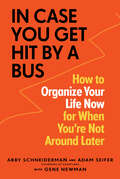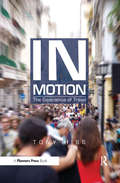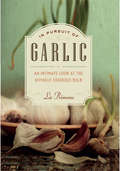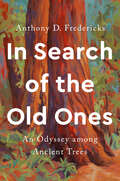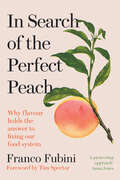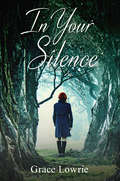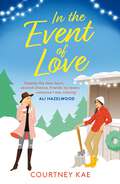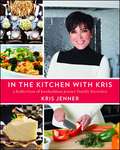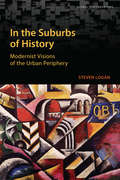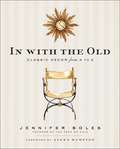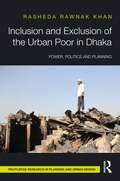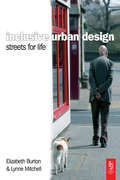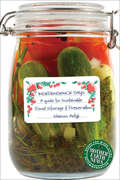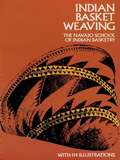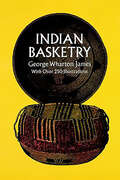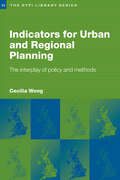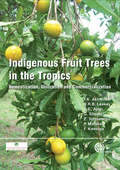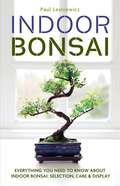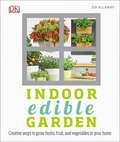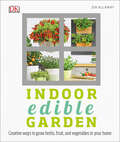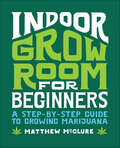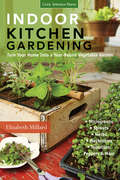- Table View
- List View
In Case You Get Hit by a Bus: How to Organize Your Life Now for When You're Not Around Later
by Gene Newman Abby Schneiderman Adam SeiferA step-by-step program for getting your life in order, so you&’re prepared for the unexpected. The odds of getting hit by a bus are 495,000 to 1. But the odds that you&’re going to die some day? Exactly. Even the most disorganized among us can take control of our on- and off-line details so our loved ones won&’t have to scramble later. The experts at Everplans, a leading company in digital life planning, make it possible in this essential and easy-to-follow book. Breaking the task down into three levels, from the most urgent (like granting access to passwords), to the technical (creating a manual for the systems in your home), to the nostalgic (assembling a living memory), this clear, step-by-step program not only removes the anxiety and stress from getting your life in order, it&’s actually liberating. And deeply satisfying, knowing that you&’re leaving the best parting gift imaginable. When you finish this book, you will have:A system for managing all your passwords and secret codesOrganized your money and assets, bills and debtsA complete understanding of all the medical directives and legal documents you need––including Wills, Powers of Attorney, and TrustsA plan for meaningful photos, recipes, and family heirloomsRecords of your personal history, interests, beliefs, and life lessonsAn instruction manual for your home and vehiclesYour funeral planned and obituary written (if you&’re up for it)
In Motion: The Experience of Travel
by Tony HissIn this extraordinarily wide-ranging, insightful, and revelatory book, Tony Hiss is the much-praised author of The Experience of Places delves into a unique and instantly recognizable (though previously undescribed) experience that can happen to us when we travel, a special understanding and ability that can leave us feeling exhilarated. He illustrates how throughout human history - from our ancestors walking upright for the first time to astronauts walking on the moon - we have repeatedly availed ourselves of this seemingly elusive quality, which he calls 'Deep Travel.' The sensation of Deep Travel can overtake us, Hiss says, whenever we tap into a sophisticated, wide-awake awareness we all possess. With a wealth of examples - from evocative accounts of his own journeys to celebrated travel writing across the centuries - Hiss identifies and rescues this powerful capacity and sets out simple techniques for accessing it no matter where we are.And this is only a jumping-off point for an original and penetrating explanation of how Deep Travel radically alters our perception of not only where we are but also when we are, by placing us in an 'extended present,' and how it acts as an open-sesame to enlarge and enrich the world around us. Going even further, he investigates how we can remain absolutely still but travel in time itself, as our horizons move backward to include layers of nature and human culture that have gone before, or project us forward to consider what our actions will mean to those who will inhabit our spot on earth a few generations from now.Whether travel takes you around the corner or around the world, once you've read In Motion, no journey will ever feel the same.
In Pursuit of Garlic: An Intimate Look at the Divinely Odorous Bulb
by Liz PrimeauThe author of Front Yard Gardens celebrates the joy of garlic—from its culinary history to advice on growing and cooking with the indispensable ingredient. Liz Primeau&’s love affair with garlic began when her teenaged boyfriend took her to an Italian restaurant for spaghetti served with heavenly garlic-laced meatballs, a sublime escape from the bland English dinners she was used to at home. Here, Primeau celebrates that culinary love, discussing garlic's central place in her kitchen and garden, as well as its role in history, art, medicine, and science. Primeau shares the pleasing ritual of beginning each dinner she cooks by chopping garlic, the secret of removing garlic's tight jacket with a confident smack of a knife, as well as her favorite garlic-centered recipes. Primeau also discusses the many varieties of garlic and gives invaluable tips for growing your own. She visits garlic fairs, where she tries to track down France's elusive L'ail Rose, and she explores the issue of cheap Chinese garlic, which has invaded the North American market to the exclusion of local varieties."Packed with fascinating facts, practical advice on growing, curing and storage, recipes and personal stories.&” —Winnipeg Free Press
In Search of the Old Ones: An Odyssey among Ancient Trees
by Anthony D. FredericksAn extraordinary journey to visit the oldest trees in the United States that beautifully reveals the connection between humans and natural history— a perfect read for nature lovers and fans of The Hidden Life of Trees.Follow award-winning author Anthony D. Fredericks's adventures across the United States to uncover the remarkable secrets and lives of ancient trees. He introduces some of the oldest trees in the country using up-to-date research, interviews with scientists, captivating storytelling, and a contagious wonder for the natural world. Fredericks's visits to the trees turn readers into fellow travelers. Through firsthand accounts and scientific detail, these enduring trees come to life off the page.Each chapter begins with a time-travel story that immerses readers in Earth's past, as early as ~58,000 BCE, for a sweeping view of what was happening during human history when the ancient tree took root. It then zooms into present-day to investigate the tree in all its mature glory and the changed world around it.Some of the featured trees include: A 13,000-year-old Palmer's oak in California that survives by cloning itselfThe 1,200-year-old Seven Sisters Oak in Louisiana that has survived in the path of at least ten major hurricanes2,000-year-old redwoods (the tallest trees in the world) on the California coastThe 2,628 year old bald cypress in the Black River of North CarolinaMarvelously detailed and deeply passionate, In Search of the Old Ones will transform your perspective of the trees and forests around you.
In Search of the Perfect Peach: Why flavour holds the answer to fixing our food system
by Franco FubiniWITH A FOREWORD FROM TIM SPECTOR, author of The Diet Myth, Spoon-Fed and Food for Life ‘This book is a passionate rallying call for a change of mindset…’ Mail on Sunday "A pioneering approach."—Anna Jones, cook and bestselling author of Easy Wins "By valuing and reclaiming flavour, Franco argues that we can transform the system and also enrich our relationship with food. Essential reading."—Dan Saladino, journalist, broadcaster and author of Eating to Extinction Let flavour guide our food choices – and lead us to a better food future. In Search of the Perfect Peach shows us how this simple desire can bring about a healthier, tastier and brighter future for our food, the people who produce it and the soil it grows in. That first bite of a perfectly ripe peach can be truly transformative – a joyful moment that will stay with you forever. For Franco Fubini, founder and CEO of Natoora, this encounter also leads him to realise that flavour is not simply a fleeting, visceral experience but a window into the farmer, a connection to our natural environment and a taste test for our food system. What makes a great-tasting tomato? Why is scarring on a greengage a good sign? Does ‘eating local’ narrow our priorities to the exclusion of others? In Search of the Perfect Peach follows Franco as he navigates the food system in pursuit of this elusive element. As he takes us from Sicily’s citrus groves to the streets of Mexico City, he shows how we have allowed the wider industry to compromise on more than just flavour. Franco’s search for the Greta peach culminates in his own clarity and conviction: by looking to flavour, we can unpick the industrialisation of our food production, restore nutrition and seasonal diversity to our plates and the craft of growing back to our landscapes. And, above all, we can find that perfect peach every summer. "This exciting and important book now brings Natoora and all its ingredients not just to restaurants like ours but … to everyone’s home."—Ruth Rogers, chef and co-founder of The River Cafe "An incredible read for those who love food and care about its future. In Search of the Perfect Peach is both a love story and technical guide."—Kyle Connaughton, chef and owner of SingleThread Farm, Restaurant and Inn
In Search of the Perfect Peach: Why flavour holds the answer to fixing our food system
by Franco FubiniWITH A FOREWORD FROM TIM SPECTOR, author of The Diet Myth, Spoon-Fed and Food for LifeNamed BBC Radio 4's The Food Programme Book of the Year, chosen by Dan Saladino"Fubini takes readers on a tour—from tomato growers in Italy to flower farmers in Cornwall to citrus groves in California . . . [and] makes a compelling case for strengthening the connections between consumers and farmers."—Civil Eats"A pioneering approach."—Anna Jones, cook and bestselling author of Easy WinsLet flavour guide our food choices – and lead us to a better food future. In Search of the Perfect Peach shows us how this simple desire can bring about a healthier, tastier and brighter future for our food, the people who produce it and the soil it grows in.That first bite of a perfectly ripe peach can be truly transformative – a joyful moment that will stay with you forever. For Franco Fubini, founder and CEO of Natoora, this encounter also leads him to realise that flavour is not simply a fleeting, visceral experience but a window into the farmer, a connection to our natural environment and a taste test for our food system.What makes a great-tasting tomato? Why is scarring on a greengage a good sign? Does &‘eating local&’ narrow our priorities to the exclusion of others? In Search of the Perfect Peach follows Franco as he navigates the food system in pursuit of this elusive element. As he takes us from Sicily&’s citrus groves to the streets of Mexico City, he shows how we have allowed the wider industry to compromise on more than just flavour.Franco&’s search for the Greta peach culminates in his own clarity and conviction: by looking to flavour, we can unpick the industrialisation of our food production, restore nutrition and seasonal diversity to our plates and the craft of growing back to our landscapes. And, above all, we can find that perfect peach every summer."This exciting and important book now brings Natoora and all its ingredients not just to restaurants like ours but … to everyone&’s home."—Ruth Rogers, chef and co-founder of The River Cafe"An incredible read for those who love food and care about its future. In Search of the Perfect Peach is both a love story and technical guide."—Kyle Connaughton, chef and owner of SingleThread Farm, Restaurant and Inn"By valuing and reclaiming flavour, Franco argues that we can transform the system and also enrich our relationship with food. Essential reading."—Dan Saladino, journalist, broadcaster and author of Eating to Extinction
In Your Silence: The Wildham Series (The Wildham Series #3)
by Grace LowrieReeling from his ex-girlfriend Cally's disappearance, Liam, a giant of a man and teetotaller, wins a commission to restore the neglected grounds of a mansion, Wildham Hall, for its owner Gregory Sinclair. It is there that Liam meets Gregory's daughter Melody, who is mute. Liam has always suppressed the darkest side of himself, but as his clandestine liaison with Melody develops, she tests him and his deepest desires are dragged to the surface.
In Your Silence: The Wildham Series (The\wildham Ser. #3)
by Grace LowrieReeling from his ex-girlfriend Cally's disappearance, Liam, a giant of a man and teetotaller, wins a commission to restore the neglected grounds of a mansion, Wildham Hall, for its owner Gregory Sinclair. It is there that Liam meets Gregory's daughter Melody, who is mute. Liam has always suppressed the darkest side of himself, but as his clandestine liaison with Melody develops, she tests him and his deepest desires are dragged to the surface.
In the Event of Love: A sweet and steamy Christmas rom-com! (Fern Falls)
by Courtney KaeGoodreads Summer Romance Reading RecommendationBuzzfeed's Most Anticipated LGBTQ Romances of 2022'Exactly the slow-burn, second-chance, friends-to-lovers romance I was craving' ALI HAZELWOOD'The perfect holiday romance! . . . Move over, Stars Hollow. I'm moving to Fern Falls!' Lacie Waldon'The holiday romance of my dreams! The sweetness of a Hallmark holiday movie, set in a town that rivals Schitt's Creek, with plenty of steamy scenes to heat things up!' Falon Ballard'Wintry perfection, a cozy flannel blanket of a book that wraps its reader in the warmest hug' Rachel Lynn SolomonOffering a steamy, queer spin on the feel-good tropes Hallmark movie, this sweet, funny #OwnVoices rom-com is perfect for fans of Casey McQuiston and Alexandria Bellefleur!......................................... With her career as a successful Los Angeles event planner imploding, Morgan Ross isn't just heading home for the holidays, it's more of a strategic retreat. Breathtaking mountain backdrops, acres of pine trees, quirky townsfolk, and charming small businesses aside, Fern Falls is also the setting of Morgan's greatest heartbreak - and she'll do anything to avoid her one-time best friend turned first love, Rachel Reed. But when Morgan discovers that Rachel's struggling Christmas tree farm is the only thing standing between Fern Falls and a corporate takeover, she has to put her heartbreak on hold. Pouring her focus into planning the perfect Christmas event to save the town, Morgan finds herself spending more and more time with Rachel. Who can blame them if the romance of the season starts to get to them? Morgan knows one thing for sure though: she and Rachel will never have a heart-warming happy ending. And, anyway, she's only here for Christmas . . . right? .........................................'Sparkles with humor and charm. The residents of Fern Falls will draw you in with their warm banter and open hearts, while the sapphic romance will heat you up faster than a cup of hot cocoa on a snowy day' Sonia Hartl'Will make your heart soar. A sexy, sparkling debut' Annette Christie'Reads like a Hallmark Christmas movie and goes down like a mug of peppermint hot chocolate... Cozy, comforting, and surprisingly steamy - this is the queer Christmas story we deserve!' Alison Cochrun'Sweet as a cup of hot cocoa (with some spice mixed in) . . . the feel-good, queer, second-chance holiday romance we've all been waiting for' Anita Kelly'Kae's sparkling voice wraps you up like a warm blanket' Ava Wilder'Ultra cozy, heart-meltingly sweet, and full of warm wit. Courtney Kae shines with a fresh, bright voice and supremely relatable characters including a dreamy lumberjane who instantly stole my heart!' Rosie Danan'With its charming small town, snowy mountaintop kisses, and dreamy lesbian lumberjane, In the Event of Love is perfect for the holidays!' Helen Hoang
In the Kitchen with Kris: A Kollection of Kardashian-Jenner Family Favorites
by Kris JennerFrom America's favorite momager comes a new cookbook and entertainment guide filled with Kris Jenner's very own insightful tips and favorite recipes.Kris Jenner has done everything under the sun from starring as the matriarch in Keeping Up With the Kardashians to writing a New York Times bestselling memoir entitled Kris Jenner... And All Things Kardashian. Inside this incredible cookbook, you'll find nearly 70 favorite recipes that have become the centerpiece of Kardashian-Jenner family traditions. This book is another way to bring fans into Kris's home with recipes and entertaining tips that can be used by anyone and everyone. Join Kris as she rolls up her sleeves to dish out tips on how to do it all and have it all in her new cookbook/entertainment guide.
In the Suburbs of History: Modernist Visions of the Urban Periphery (Global Suburbanisms)
by Steven LoganIn the 1960s, socialist and capitalist urban planners, architects, and city officials chose the urban periphery as the site to test out new ideas in modernist architecture and planning: the outskirts of Prague and a bedroom suburb of Toronto would be the sites for experimental urban development. In the Suburbs of History overcomes the divisions between East and West to reassemble the shared histories of modern architecture and urbanism as it shaped and re-shaped the periphery. Drawing on archives, interviews, architectural journals, and site visits to the peripheries of Prague and Toronto, Steven Logan reveals the intertwined histories of capitalist and socialist urban planning. From socialist utopias to the capitalist visions of the edge city, the history of the suburbs is not simply a history of competing urban forms; rather, it is a history of alternatives that advocated collective solutions over the dominant model of single-family home ownership and car-dominated spaces.
In with the Old: Classic Decor from A to Z
by Jennifer BolesThe Peak of Chic blogger Jennifer Boles--who counts Newell Turner, Alexa Hampton, Stephen Drucker, and Veranda founder Lisa Newsom among her loyal readers--presents a charming encyclopedia of 100 of the most stylish decorating details (chintz, striped walls, and orangeries) that were favored by the great tastemakers of the twentieth century. Best of all, Jennifer gives helpful tips on decorating with these traditional flourishes today.The 1930s to the 1960s were a grand time for decorating: they saw Chippendale chairs and grotto furniture, house stationery, monograms, tented rooms, and vanities--much of which has since been forgotten or taken for granted. In In with the Old Jennifer Boles breathes new life into gracious living with 100 entries organized from A to Z on her favorite decorating essentials of the past. Each entry explores curious facts, anecdotes, and timeless advice plucked from the legacies of Billy Baldwin, Dorothy Draper, Sister Parish, the Duchess of Windsor, and other tastemakers whose influence continues today. With a foreword by Alexa Hampton and charming illustrations and photographs, In with the Old is a guide to stylish living that will inspire and delight.From the Hardcover edition.
Inclusion and Exclusion of the Urban Poor in Dhaka: Power, Politics, and Planning
by Rasheda Rawnak KhanInclusion and Exclusion of the Urban Poor in Dhaka explores how the inhabitants of poor neighborhoods in Dhaka, Bangladesh, gain inclusion in the city at the face of exclusion. The book considers how the people of poor neighborhoods encounter the exclusionary behavior of city development, and how their inclusionary attempts have influenced the urban design. The book is presented in two parts: first, it explains how people in poor neighborhoods face exclusion because of the imbalance of power and politics. Second, it demonstrates how the existing exclusion of urban poor is affecting their strategies to gain access to urban services through people’s power and politics. Focusing on the transdisciplinary field of urban anthropology, the chapters uncover the urban forces, policies and actions that facilitate urban politics. It also investigates the people who live in poor neighborhoods, who in the face of exclusion, have included themselves in urban development planning and design by employing diverse strategies against those forces in the urban politics, e.g., accepting dominance, bargaining, or having control over their lives. This book will recontextualize an ethnographic inquiry into the exclusion and inclusion of the people within city development design, plans and innovations in applications of anthropological theory and methodology. This book will encourage the reader to understand the politics of state’s development projects and plans, and furthermore instigate the city government, planners and policymakers to focus on the people's political power and agency that enables them to achieve inclusion. It will therefore be of interest to researchers and students of urban planning and development, urban geography, and urban anthropology, as well as planning professionals and policymakers.
Inclusive Urban Design: Streets For Life
by Elizabeth Burton Lynne MitchellThis is the first book to address the design needs of older people in the outdoor environment. It provides information on design principles essential to built environment professionals who want to provide for all users of urban space and who wish to achieve sustainability in their designs. Part one examines the changing experiences of people in the outdoor environment as they age and discusses existing outdoor environments and the aspects and features that help or hinder older people from using and enjoying them. Part two presents the six design principles for ‘streets for life’ and their many individual components. Using photographs and line drawings, a range of design features are presented at all scales of the outdoor environment from street layouts and building form to signs and detail. Part three expands on the concept of ‘streets for life’ as the ultimate goal of inclusive urban design. These are outdoor environments that people are able to confidently understand, navigate and use, regardless of age or circumstance, and represent truly sustainable inclusive communities.
Independence Days: A Guide to Sustainable Food Storage & Preservation (Mother Earth News Books for Wiser Living)
by Sharon Astyk&“Be warned! Independence Days will change the way you eat. It is not just a guide for storing food but a manual for living in a changing world.&” —Kathy Harrison, author of Prepping 101 Hard times aren&’t just coming, they are here already. The recent economic collapse has seen millions of North Americans move from the middle class to being poor, and from poor to hungry. At the same time, the idea of eating locally is shifting from being a fringe activity for those who can afford it to an essential element of getting by. But aside from the locavores and slow foodies, who really knows how to eat outside of the supermarket and out of season? And who knows how to eat a diet based on easily stored and home preserved foods? Independence Days tackles both the nuts and bolts of food preservation, as well as the host of broader issues tied to the creation of local diets. It includes: · How to buy in bulk and store food on the cheap · Techniques, from canning to dehydrating · Tools—what you need and what you don&’t In addition, it focuses on how to live on a pantry diet year-round, how to preserve food on a community scale, and how to reduce reliance on industrial agriculture by creating vibrant local economies. Better food, plentiful food, at a lower cost and with less energy expended: Independence Days is for all who want to build a sustainable food system and keep eating—even in hard times. &“[Astyk] builds a sturdy path to a full larder, a safe family, and a more secure community.&” —Robin Wheeler, author of Food Security for the Faint of Heart
Indian Basket Weaving
by Navajo School of Indian BasketryThe methods of Indian basket weaving explained in this excellent manual are the very ones employed by native practitioners of the craft. members of the Navajo School of Basketry have set down their secrets in clear and simple language, enabling even the beginner to create work that can rival theirs in grace, design, and usefulness.Beginning with basic techniques, choice of materials, preparation of the reed, splicing, the introduction of color, principles and methods of design, shaping the basket and weaves from many cultures, such as Lazy Squaw, Mariposa, Taos, Samoan, Klikitat, and Shilo, each accompanied by specific instructions. There are suggestions for the weaving of shells, beads, feathers, fan palms, date palms, and even pine needles, and recipes for the preparation of dyes.Examples of each type of basket are illustrated by photographs, often taken from more than one angle so that the bottom can be seen as well as the top and sides. Close-up photography of the various types of stitching, especially at the crucial stage of beginning the basket, is an invaluable aid to the weaver. In addition, the authors have provided line drawings which are exceptionally clear magnifications of the various weave patterns.Anyone who follows the lessons contained in this book will have a knowledge of basketry unattainable in any other way. They are so lucid and complete that the amateur as well as the experienced weaver will be able to manufacture baskets distinguishable from authentic native articles only in that they were not woven by Indians. For those who merely seek a broader knowledge of American Indian arts, the book provides a comprehensive introduction to the subject of basketry.
Indian Basketry
by George W. JamesSince it first publication in 1901, this pioneering study by George Wharton James, once a leading collector and authority, has become a valuable source book for American Indian basketry. From Poma mush baskets to Paiute dicing trays, Indian Basketry traces the origin, development, and fundamental principles of Indian basket designs for the major tribal units in Southwestern United States and Pacific Coast, with occasional comments on the basket weaving of a number of other North American tribes.Author of several books on the Southwest, George James has used his extensive experience in the field to compile indispensable information (much gathered directly through interviews with Indian basketmakers) covering nearly every aspect of Indian basketry: esthetics, designs, dyes, and coloration, weaving and stitching techniques (including the bamtush and dah-lah methods), basket types, tribal variation, and functional considerations, offering clear instructions for those who may be interested in reproducing these ancient American crafts. James also includes a description of various native weaving materials such as pine root, bark, sumac, willow, twigs, fern stalks, grass and palm fronds, with suggestions regarding the ways in which the Indians wove shells, feathers, beads, leather, and pine needles into their basket designs.The book is a valuable aid for the artist, designer, and craftsman, or even for the beginner, who may wish to re-create authentic and often extinct basket forms and decorative motifs. It is also most useful to the collector, cultural historians, ethnologist, scholar, or buff, who desires to know more about specific aspects of Indian basketry, or about Indian arts in general. As an important contribution to the historiography of American Indian culture, this may be one of the most practical Indian basketry books that you could own.
Indicators for Urban and Regional Planning: The Interplay of Policy and Methods (RTPI Library Series)
by Cecilia WongThis book focuses on the measurement and utilisation of quantitative indicators in the urban and regional planning fields. There has been a resurgence of academic and policy interest in using indicators to inform planning, partly in response to the current government's information intensive approach to decision-making. The content of the book falls into three broad sections: indicators usage and policy-making; methodological and conception issues; and case studies of policy indicators.
Indigenous Fruit Trees in the Tropics: Domestication, Utilization and Commercialization
by Festus K. Akinnifesi Oluyede C. Ajayi Patrick Matakala Freddie R. Kwesiga Gudeta Sileshi Zac Tchoundjeu Roger R. B. LeakeyFocusing on livestock production systems, this comprehensive text addresses how the growing diversity of global food demands will be met in the future, providing insights into new and emerging scientific areas and the implications for addressing global drivers for change.
Indoor Bonsai
by Paul Lesniewicz"Excellent guide...with specifics on individual plants." - The New York Times.A bonsai is a miniature tree. Grown in a shallow dish, it resembles larger trees in all respects except size, and lives to an equally old age.The conventional bonsai requires a site in the open air where the plant is exposed to the sun, wind and rain in order to develop and remain healthy. In this book, however, Paul Lesniewicz looks at those species that can successfully be kept indoors all year round. He explores a vast variety of bonsai trees, including mini versions, which are only 3-6 inches tall, for those who are really lacking in space.Indoor Bonsai includes sections such as choosing a plant or growing it from seed, planting, general care, pests and diseases, shaping, wiring and pruning, and many other aspects, all explained in simple and straightforward terms. Advice is accompanied by step-by-step illustrations and spectacular colour photography throughout, to help you choose and care for your bonsai tree.Paul's guidance is not a one-size-fits-all approach; his sensible and easy-to-follow advice will help each gardener to create their own individual work of art.
Indoor Bonsai
by Paul Lesniewicz"Excellent guide...with specifics on individual plants." - The New York Times. A bonsai is a miniature tree. Grown in a shallow dish, it resembles larger trees in all respects except size, and lives to an equally old age.The conventional bonsai requires a site in the open air where the plant is exposed to the sun, wind and rain in order to develop and remain healthy. In this book, however, Paul Lesniewicz looks at those species that can successfully be kept indoors all year round. He explores a vast variety of bonsai trees, including mini versions, which are only 3-6 inches tall, for those who are really lacking in space.Indoor Bonsai includes sections such as choosing a plant or growing it from seed, planting, general care, pests and diseases, shaping, wiring and pruning, and many other aspects, all explained in simple and straightforward terms. Advice is accompanied by step-by-step illustrations and spectacular colour photography throughout, to help you choose and care for your bonsai tree.Paul's guidance is not a one-size-fits-all approach; his sensible and easy-to-follow advice will help each gardener to create their own individual work of art.
Indoor Edible Garden
by Janette Marshall Zia AllawayMake the most of your space, from balconies and windowsills to countertops, walls, and even ceilings, to grow herbs, vegetables, and flowers in your home that look amazing and taste even better. Featuring 28 innovative step-by-step projects, Indoor Edible Garden is a highly visual guide full of practical tips and stylish ideas for how to create edible indoor gardens using whatever space you have available. Use your space and light in clever ways, brightening your home with unique living decorations. Inspiring from the start, this book shows off its lush garden projects through beautiful design and full-color photographs. Reference more than 30 profiles of the top herbs, edible flowers, fruiting plants, and vegetables. Follow DIY project templates to grow your gardens into beautiful home decor. The step-by-step instructions include how to create a hanging chili and basil ball, how to grown your own tea leaves, how to sprout microgreens in cupcake liners, and more. Plus, this guide also includes straightforward explanations of scientific methods such as artificial lighting and hydroponics and key techniques for planting, drainage, and harvesting. Indoor Edible Garden helps create stunning and edible home decor so your living space will be fruitful--and beautiful--all year round.
Indoor Edible Garden: Creative Ways to Grow Herbs, Fruits, and Vegetables in Your Home
by Zia AllawayMake the most of your space, from balconies and windowsills to countertops, walls, and even ceilings, to grow herbs, vegetables, and flowers in your home that look amazing and taste even better.Featuring 28 innovative step-by-step projects, Indoor Edible Garden is a highly visual guide full of practical tips and stylish ideas for how to create edible indoor gardens using whatever space you have available. Use your space and light in clever ways, brightening your home with unique living decorations. Inspiring from the start, this book shows off its lush garden projects through beautiful design and full-color photographs.Reference more than 30 profiles of the top herbs, edible flowers, fruiting plants, and vegetables. Follow DIY project templates to grow your gardens into beautiful home decor. The step-by-step instructions include how to create a hanging chili and basil ball, how to grown your own tea leaves, how to sprout microgreens in cupcake liners, and more. Plus, this guide also includes straightforward explanations of scientific methods such as artificial lighting and hydroponics and key techniques for planting, drainage, and harvesting.Indoor Edible Garden helps create stunning and edible home decor so your living space will be fruitful—and beautiful—all year round.
Indoor Grow Room for Beginners: A Step-By-Step Guide to Growing Marijuana
by Matthew McClureGrow your own marijuana indoors with help from this comprehensive guideEven if you have no experience, growing marijuana at home is easy once you learn the basics. This step-by-step guide provides novice growers with simple instructions on how to set up an indoor growing space and nurture high-quality buds. Find advice for each stage of the process, from choosing the right space, equipment, and strains, to planting, caring for, and cultivating a thriving crop.In this guide to growing marijuana indoors, you'll find:An overview of the basics—Explore the anatomy and life cycle of the cannabis plant, the four fundamentals of growing marijuana, and common myths and misconceptions.The complete setup—Learn the pros and cons of growing marijuana in a closet, tent, or grow room, and get comprehensive instructions and equipment lists that work for any indoor setting.Visual guidance—Detailed diagrams and illustrations clearly explain complex concepts so you can grow cannabis at home with confidence.Tips for growing the best buds—Discover at-a-glance tables that make it easy to harvest hearty, seedless buds, with information on how to rig lighting, lay out your space, maintain proper nutrients, control pests, and prune your plants.Discover the joy of growing marijuana with this comprehensive guide to indoor cultivation for beginners.
Indoor Kitchen Gardening: Turn Your Home Into a Year-Round Vegetable Garden
by Elizabeth MillardAs featured in The New York Times, grow amazing, fresh, organic produce in your own home with this critically acclaimed indoor gardening manual.It takes just a few dollars and a few days for you to start enjoying fresh, healthy produce grown indoors. Imagine serving a home-cooked meal highlighted with beet, arugula, and broccoli microgreens grown right in your kitchen, accompanied by sautéed winecap mushrooms grown in a box of sawdust in your basement. Explore the expansive new world of growing and eating that can be discovered with the help of Indoor Kitchen Gardening.Author and Bossy Acres CSA co-owner Elizabeth Millard teaches you how to grow microgreens, sprouts, herbs, mushrooms, tomatoes, peppers, and more—all inside your own home, where you won’t have to worry about seasonal changes or weather conditions. In this guide, you will find: ·An introduction to growing edibles indoors, from defining your goals and choosing a space, containers, soil, and grow lights to troubleshooting common problems.·Guidance for growing crops perfectly suited to an indoor environment and that often have quick seed-to-harvest timeframes, such as microgreens, shoots, herbs, wheatgrass, sprouts, and mushrooms. ·Guidance for growing crops with shallow root systems that grow well indoors—such as radishes, carrots, lettuces, and tomatoes. ·Plenty of cheerleading to encourage your sense of adventure.Filled with photos and more than two hundred pages of do-it-yourself in-home gardening information and projects, Indoor Kitchen Gardening is your gateway to this exciting new growing method.“Well-written, clearly illustrated and full of personality.” —Northern Gardener“This is a great book for both beginners and seasoned gardeners.” —The American Gardener Magazine from The American Horticultural Society
